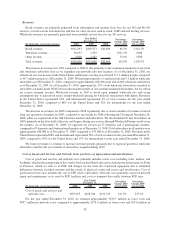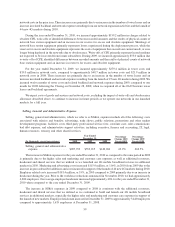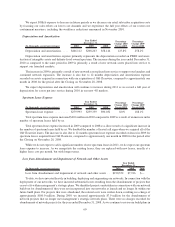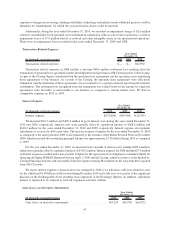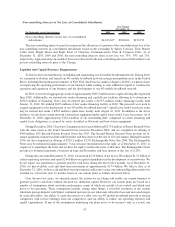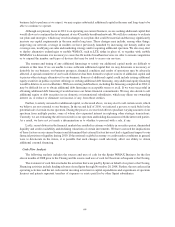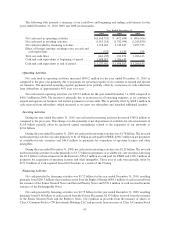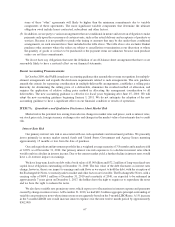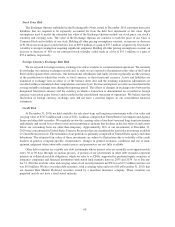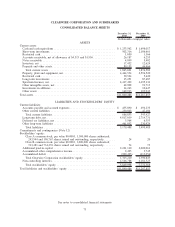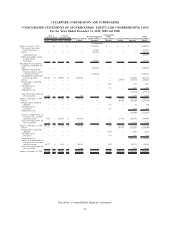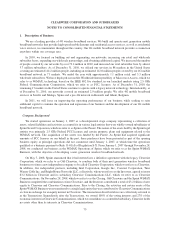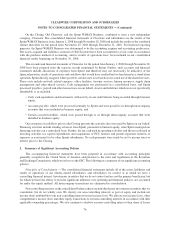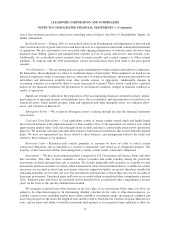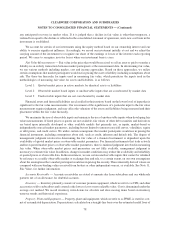Clearwire 2010 Annual Report Download - page 73
Download and view the complete annual report
Please find page 73 of the 2010 Clearwire annual report below. You can navigate through the pages in the report by either clicking on the pages listed below, or by using the keyword search tool below to find specific information within the annual report.Stock Price Risk
The Exchange Options embedded in the Exchangeable Notes issued in December 2010 constitute derivative
liabilities that are required to be separately accounted for from the debt host instrument at fair value. Input
assumptions used to model the estimated fair value of the Exchange Options include our stock price, our stock’s
volatility and carrying costs. The value of the Exchange Options are sensitive to both the price of our Class A
Common Stock and volatility of our stock. Holding all other pricing assumptions constant, an increase or decrease
of $1.00 on our stock price could result in a loss of $69.0 million or a gain of $59.7 million, respectively. Our stock’s
volatility is an input assumption requiring significant judgment. Holding all other pricing assumptions constant, an
increase or decrease of 10% in our estimated stock volatility could result in a loss of $51.5 million or a gain of
$53.6 million, respectively.
Foreign Currency Exchange Rate Risk
We are exposed to foreign currency exchange rate risk as it relates to our international operations. We currently
do not hedge our currency exchange rate risk and, as such, we are exposed to fluctuations in the value of the United
States dollar against other currencies. Our international subsidiaries and equity investees generally use the currency
of the jurisdiction in which they reside, or local currency, as their functional currency. Assets and liabilities are
translated at exchange rates in effect as of the balance sheet date and the resulting translation adjustments are
recorded within accumulated other comprehensive income (loss). Income and expense accounts are translated at the
average monthly exchange rates during the reporting period. The effects of changes in exchange rates between the
designated functional currency and the currency in which a transaction is denominated are recorded as foreign
currency transaction gains (losses) and recorded in the consolidated statement of operations. We believe that the
fluctuation of foreign currency exchange rates did not have a material impact on our consolidated financial
statements.
Credit Risk
At December 31, 2010, we held available-for-sale short-term and long-term investments with a fair value and
carrying value of $517.6 million and a cost of $511.1 million, comprised of United States Government and Agency
Issues and other debt securities. We regularly review the carrying value of our short-term and long-term investments
and identify and record losses when events and circumstances indicate that declines in the fair value of such assets
below our accounting basis are other-than-temporary. Approximately 34% of our investments at December 31,
2010 were concentrated in United States Treasury Securities that are considered the least risky investment available
to United States investors. The remainder of our portfolio is primarily comprised of United States agency and other
debentures. The estimated fair values of these investments are subject to fluctuations due to volatility of the credit
markets in general, company-specific circumstances, changes in general economic conditions and use of man-
agement judgment when observable market prices and parameters are not fully available.
Other debt securities are variable rate debt instruments whose interest rates are normally reset approximately
every 30 or 90 days through an auction process. A portion of our investments in other debt securities represent
interests in collateralized debt obligations, which we refer to as CDOs, supported by preferred equity securities of
insurance companies and financial institutions with stated final maturity dates in 2033 and 2034. As of Decem-
ber 31, 2010 the total fair value and carrying value of our security interests in CDOs was $15.3 million and our cost
was $9.0 million. We also own other debt securities, with a carrying value and cost of $0 at December 31, 2010, that
are Auction Rate Market Preferred securities issued by a monoline insurance company. These securities are
perpetual and do not have a final stated maturity.
68


